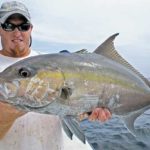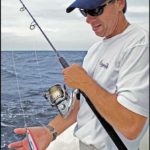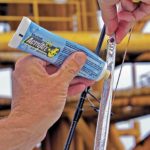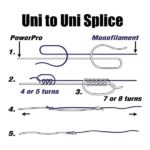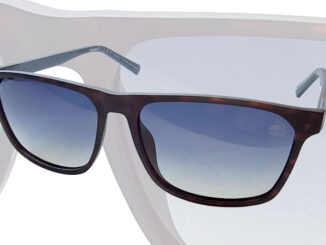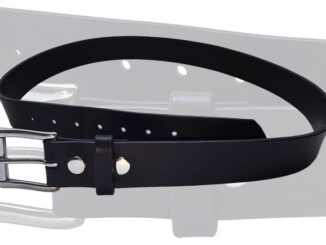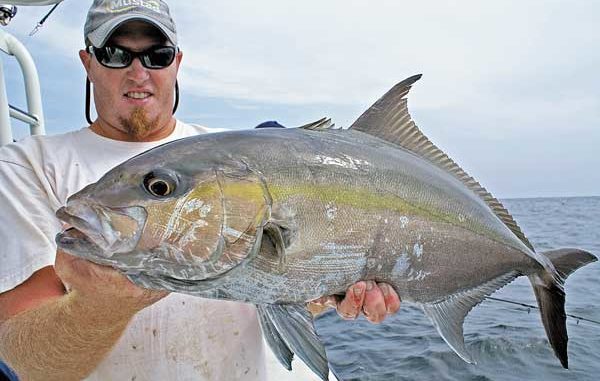
Leave the heavy gear at home, and try this now-popular technique for loading a boat with offshore fish.
I’m not sure what woke me first, the alarm clock or the repetitive lightning and thunder. As we rolled out of the bunks, my lower bunk mate, Johnny Gelpi, loudly stated — “We’re gonna die!” As we headed out of the houseboat at Venice Marina, a stiff breeze and continued lightning strikes pointed to anything but a successful offshore tuna trip.
We made the short drive over to Cypress Cove to meet our captain, Kevin Beach, who runs the Pale Horse, a 30-foot aluminum cat powered by twin Yamaha 350s. The back of Beach’s shirt proclaimed an unusual biblical passage: “BEWARE the man on the pale horse … for he is death and HELL FOLLOWS with him.”
Maybe Gelpi was right!
For today’s trip, I would be joining Jeff Pierce, sales director for Mustad; Drew Davis, Mustad factory rep; Anthony Puglia of Puglia’s Sporting Goods; and Gelpi, one of Puglia’s salesmen. Pierce checked out the surrounding thunderstorms on his I-phone radar link.
“They’re green, and they’re small,” he said.
Despite the ominous weather, it was a go.
Although he had already been fishing hard for several days straight, Pierce was not about to let a little nasty weather keep him from testing some of Mustad’s new products. We put on the rain gear, climbed aboard the Pale Horse and off we went. The plan was tuna. We ran for a while out of Baptiste Collette, and stopped at a mooring buoy to make bait.
The Mustad sabikis quickly filled the livewell with frisky hardtails and a few threadfin herring. With storms all around, we headed several miles offshore into what can only be described as angry seas. The big cat’s ride was smooth with only the occasional thrust to one side or the other.
Beach piloted through the building waves with the boat going airborne now and then. However, you could feel the effect of the air cushion as the dual hulls gently set back down. I was firmly tucked into the beanbag, so the ride was comfortable and not the least bit bone-jarring. All I could think of was how different this ride would be in a mono-hull.
After reaching the targeted rig, Beach immediately saw an unwelcome sight. Large schools of hardtails flipped and frolicked carefree far out from the rig.
“That’s not a good sign,” he said. “If they’re comfortable that far out from the rig, there mustn’t be anything here to eat them.”
The windsock on the rig was stretched straight out. A radio communication between a supply boat and the rig stated tthe wind was clocked at a solid 25 m.p.h. Steady 5- to 6-foot choppy rollers pummelled us as we slow-trolled around the rig. Comfortable fishing conditions these were not.
Beach’s observation about the fearless baitfish proved correct. We dragged the hardtails for an hour without as much as a sniff.
It was now decision time; do we head further offshore in the unforgiving seas, or change plans and head closer in where fishing may be more manageable?
Beach advised that the next targeted rig was 18 miles farther out. A very quick conference between Davis and Puglia made the decision to go to plan B — in we went.
On the way, Pierce dug through his meticulously cataloged supply of jigs, assist hooks and leaders to ready his equipment for some jigging action. As we got closer to home, the storms spread apart and the seas lessened a bit. The waves were half as high, and the fishing conditions were much more comfortable.
In what seemed the middle of nowhere, the Pale Horse slowed to a crawl as Beach kept a close watch on his electronics.
“There’s a sunken oil rig here,” he said. “I call it the ‘grocery store’ because I can always get fish here even if I can’t buy one anywhere else.”
Located in just over 300 feet of water, the hurricane-wrecked rig rises a hundred or so feet off the bottom. There it was — the sketchy black bars on the Raymarine E120 clearly showed that the Pale Horse was in position.
“Drop ’em,” Beach said.
The anglers launched a variety of slender “butterfly jigs” down toward the structure. Pierce was clearly a jig aficionado. The obvious fluid motion as he combined pumping and reeling showed that he has done this a time or two. It didn’t take long.
“Fish on,” Pierce proclaimed.
With a bit of grunting and groaning, Pierce used his Shimano Stella spinning reel and braided line to haul in a fat scamp.
Next to hook up was Puglia. Pierce called out both encouragement and words of wisdom.
“He’s on the porch. Don’t let him get back in his house or you’ll lose him,” he said.
Puglia’s bright-red braided line was a stark contrast to the jet black Van Staal spinning reel. Both held up fine, and Puglia was rewarded with a nice, albeit scratched-up, almaco jack.
“The one thing about these jigs is that they will catch anything down there,” said Pierce.
That was quickly proven as each angler brought aboard a steady stream of scamp, almaco jacks and the occasional grouper. To add interest to the mix, Pierce caught a bright orange spinycheek scorpionfish and a bearded brotula, or “cusk eel.” The anglers’ mixed bag also included red snapper, bonito and a few bull redfish.
It was clear that these jigs can fool anything that swims.
When the bite would slow, Beach would have the anglers reel up their jigs so he could reposition the boat over the structure. Once on target, it was drop, jig, catch, repeat.
With a full limit of scamp and several other tasty bottom-dwellers, Beach moved the Pale Horse about a half mile to another sunken treasure. Confirmation of position attained, Beach again gave his “drop ’em” command. This time, the captain also got in on the action.
Almost instantly, calls of “Fish on!” rang out from all sides of the Pale Horse. Three anglers hooked up on one side and one on the other. It was amberjack mayhem.
For the next hour and a half, it was virtually nonstop jig and jack action. Fighting amberjack on lightweight jigging tackle is a real rush. The limit on amberjack is only one per person, so catch-and-release quickly became necessary.
Any fish that came up with its air bladder extended was carefully attended to by Pierce. He gently used his snapper venting tool to deflate the fish before releasing. Any that struggled to swim down were scooped up and vented again.
Although everyone on board caught multiple fish using the jigs, it was readily apparent Pierce was having the most success. There had to be a reason.
If there were an Olympic sport for jigging, Pierce would easily bring home Team USA a gold medal. From all points on the boat, he worked a variety of jigs with the skill of a master puppeteer. Though you could not see his jig 200 feet down, you knew it was bouncing and fluttering exactly as he commanded. His controlled presentation consistently assured more strikes and, most importantly, more hookups.
So what do you need to be a successful jig fisherman?
Puglia sells jigs and jigging tackle every day in his Metairie sporting goods store. In a short period of time, he has seen explosive growth in the sales of jigs and jigging tackle.
“Since I first started stocking jigging equipment, my inventory on jigs and jigging rods and reels has tripled,” he said. “It really is a complete system, and fishermen are catching on fast.”
Puglia further noted that he’s also seen a marked decrease in the sales of more traditional bottom-fishing gear.
“The days of buying 9/0 Senators and big meat poles are over,” he said.
Though many are initially reluctant to believe they can catch hard-fighting snapper, grouper and amberjack on such slight-looking tackle, once they experience jig fishing success, they come back for more.
“Once you convince these guys that a jigging set-up is not a redfish pole, they’re sold,” said Puglia. “It never fails. They are hesitant to purchase the first set-up, but after they use it, they come back and buy another one.”
Jigging truly is an engineered system. Properly designed and matched components provide all the elements necessary to successfully trick and whip offshore fish that were once only sought with heavy, clunky tackle and natural or live baits. Understanding each component will allow you to put together a successful jig fishing arsenal.
Jigs
Commonly referred to as “butterfly jigs,” these flat, colorful slivers of metal really don’t look like effective fish-catching weapons. However, when correctly presented, their action can perfectly mimic injured baitfish.
Jigs come in various weights and shapes. They are inherently heavy as is necessary to get them down to the depths under varying current conditions.
Some jigs come rigged with hooks, while others allow the angler to add the hook(s) of their choice. Specialty jig wallets are available to organize and easily transport a large selection of jigs.
A varied supply of colors, shapes and weights will allow you to present the right jig as the situation dictates. While jigs are relatively expensive ($5-$15 each), they are durable and can last for years.
Hooks
The hooks used on jigs are called “assist hooks.” They are truly a separate component of the jig, and should be carefully chosen. The hooks are pre-rigged on a short length of wire or Spectra, and attach to the top eye of the jig with a stout split ring. This allows the heavy jig to swing freely, and acts to eliminate leverage from the heavy jig that would otherwise work to tear the jig out of the fish’s mouth.
Jigging has become so popular worldwide that Mustad has spent significant time and money engineering assist-hook systems that Pierce considers “bomb proof.” Mustad is not in the jig business, but they made a commitment to be the leader in the manufacturing of the highest-quality assist hooks.
A good assist hook should be sharp, strong and corrosion-resistant.
“If the hook fails, everything else is useless,” said Pierce. “Mustad has an assist hook for any jigging situation.”
The Mustad assist hooks use either heavy hollow core Spectra or 49-strand wire.
“The 49-strand wire is unique to the industry, and won’t kink or cut off,” said Pierce.
The Spectra models come with Mustad’s Ultra Point, highly corrosion-resistant hooks that are “power snelled” to the Spectra. The wire models are extremely corrosion-resistant, and come with extra-strong single or treble hooks, double- barrel sleeves and free-rotating swivels. Several sizes are available.
Rods and reels
Probably the fastest-growing segment of specialty jigging equipment is rods and reels. All major manufacturers are now producing equipment designed for jigging. The heavy weight of the jigs, the strong braided lines and the tough offshore fish all combine to punish the lightweight tackle necessary to sustain an active day of jigging.
The rods need to be thinner, but at the same time sturdy. They must also have a strong power curve, which is necessary to muscle heavy fish out of sharp underwater structure. Rods such as the Shimano Trevala or the Penn Torque are specifically designed for this purpose. They can handle huge fish, yet their composite design and construction keep them extremely lightweight.
Likewise, jigging reels need to be compact and light, yet must hold a lot of line and have powerful drag systems. Spinning reels or casting reels are more a matter of personal choice, and both perform well in a variety of jigging situations.
Higher-end spinning reels, like the Shimano Sustain or Stella, are battle-proven and work well for jigging. On the casting-reel side, The Penn Torque or Shimano Trinidad or Torsa reels also stand up to the rigors of jigging. When choosing a jigging reel, Puglia recommends considering “line capacity, high gear ratio and a heavy duty drag system.”
Accessories
Fishing heavy jigs several hundred feet down around sharp structure makes using braided line a necessity. Line such as Power Pro in the 60- to 80-pound class is preferred. The extra sensitivity is needed to feel the strikes. The strong braided line is necessary to anchor the hook and quickly gain control over the fish.
In order to provide some shock absorbency and keep the braided line unseen to the fish, a leader of heavy monofilament or fluorocarbon should always be used.
Shimano offers pre-made wind-on fluorocarbon leaders that are convenient and specifically made for jig fishing. However, any quality leader material will serve the purpose as long as attention is paid to learning the proper knots to tie the braid to the leader and the leader to the jig. One of the more popular connections for leader to braid line is the uni-to-uni knot.
One other necessity for jig fishing is a quality pair of split-ring pliers. All jig/assist hook connections contain heavy split rings, and good pliers are necessary to get them on or off.
A heavy jig swinging on your rod while traveling between fishing locations will bang around and quickly cause damage. Another necessary item is a jig holder such as the Shimano Butterfly Cocoon. This handy little device is a wrap made of neoprene that Velcros around the jig to keep it tightly secured to the rod.
Some days, fish will eat anything; on others, they seem to have lockjaw. On these days, products such as Mustad’s Activate scent gel can trigger strikes from otherwise uninterested fish. The sticky gel adheres well to the hard jigs, and disburses a powerful fish-attracting scent.
Technique
While one can surely catch a fish by simply dropping a jig down and reeling it up, proper technique will greatly increase the odds and make jigging much more enjoyable. Working the jig vertically in the water column is akin to walking-the-dog on a surface lure.
“Once you get the feel and proper coordination, you can tell exactly what your jig is doing even though it’s several hundred feet down,” said Pierce.
Proper technique will only come with many days of actual fishing time, as was evident by Pierce’s smooth, instinctual presentation on each cast.
Additionally, jigging is an angler-participation sport. There’s no sending a chunk of bait down and waiting for a strike. The strikes will only come while the fisherman is actively working the jig.
Certainly, jig presentations will necessarily vary depending on the conditions and what the fish are looking for that day. However, the angler that is well tuned to his jig will always be more successful. Pierce proved that fish after fish.
Armed with the right equipment and a little practice, a variety of tasty, hard-fighting fish await those willing to give jig fishing a try. Louisiana’s offshore rigs and wrecks provide unlimited structure that offers prime jigging action.
Oh yeah, I figured it out. The death referred to on Beach’s shirt was clearly meant for the fish.
Capt. Kevin Beach can be reached at (504) 451-3886.
